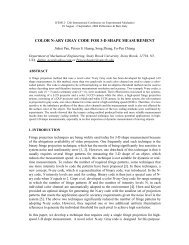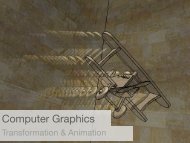First of all, we thank you for your great effort reviewing our paper ...
First of all, we thank you for your great effort reviewing our paper ...
First of all, we thank you for your great effort reviewing our paper ...
- No tags were found...
Create successful ePaper yourself
Turn your PDF publications into a flip-book with our unique Google optimized e-Paper software.
calibrated under the same lighting condition as the measurement. As long as the projector lightdoes not significantly change during the calibration process and the measurement process, thisissue will not be problematic <strong>for</strong> <strong>our</strong> system.With the Bayer pattern, the phase estimates may be impacted more than if it was done with a3‐CCD camera, since the Bayer takes alternating red,blue,green phase estimates (point by point)to make a single contiguous wrapped phase estimate, where as the 3‐CCD would have threecontiguous wrapped phase estimates (one <strong>for</strong> each color).It is true that using 3‐CCD camera has its advantages, while its drawbacks are obvious: 1) moreexpensive, 2) phase calculation becomes problematic since it is extremely difficult to guaranteethat 3 CCDs in the color cameras and 100% accurately aligned pixel by pixel. The misalignmentcould cause the phase shift error, which might be significant if the camera is at low cost. WhileBayer filtered sensor does not have the alignment issue, and cheap at the same time.We added the following statement in Section 1, on page 6:In this research, <strong>we</strong> utilized a single‐chip color camera instead <strong>of</strong> a 3‐CCD camera. The reasonsare: 1) 3‐CCD cameras are gener<strong>all</strong>y more expensive comparing with single‐sensor cameras; 2)The phase calculation might be problematic since it is extremely difficult to guarantee that 3CCDs in the color cameras are 100% accurately aligned pixel by pixel. This misalignment cancause the phase shift error, which might be significant if the camera is at low cost; and 3) theysuffers the same light loss as the single‐chip color cameras since each sensor only capturespartial spectra <strong>of</strong> the light. Of c<strong>our</strong>se, 3‐CCD cameras might provide better image quality thansingle‐chip cameras because local noise is sm<strong>all</strong>er.• The images look hastily captured with barrel distortion, uneven lighting, crooked. This mayshow robustness (although it isn't mentioned in the <strong>paper</strong>), but it looks untidy.Bear in mind that the camera (Mightex MCN‐C013‐U) <strong>we</strong> used is a 190 US $ CMOS camera asspecified in <strong>our</strong> system setup. The projector (Optoma EP739) <strong>we</strong> used is only $700 f<strong>our</strong> yearsago.We added the price <strong>of</strong> the camera and the projector in this revised version, in Section 4, onpage 12, experiments.Be<strong>for</strong>e <strong>we</strong> show the experimental results, <strong>we</strong> want to emphasize that that the camera <strong>we</strong> usedis a CMOS camera at very low cost US $190, and the projector is also very cheap, which is US$700 f<strong>our</strong> years ago. The noise <strong>of</strong> the system can be significantly reduced by utilizing a betterCCD camera and a better projector. The key <strong>of</strong> the experimental results is to demonstrate thefeasibility <strong>of</strong> this proposed technique.• There are artifacts in the 3D data, mostly where the image intensity is low. The textureappears in the 3D data. Although this is somewhat expected, it is not discussed in the <strong>paper</strong>. Italso doesn't appear in the rendered 3D object when vie<strong>we</strong>d <strong>of</strong>f axis. It looks significant enoughto affect the mesh, and widespread that it wouldn't be smoothed out by the gaussian filter. Can
















